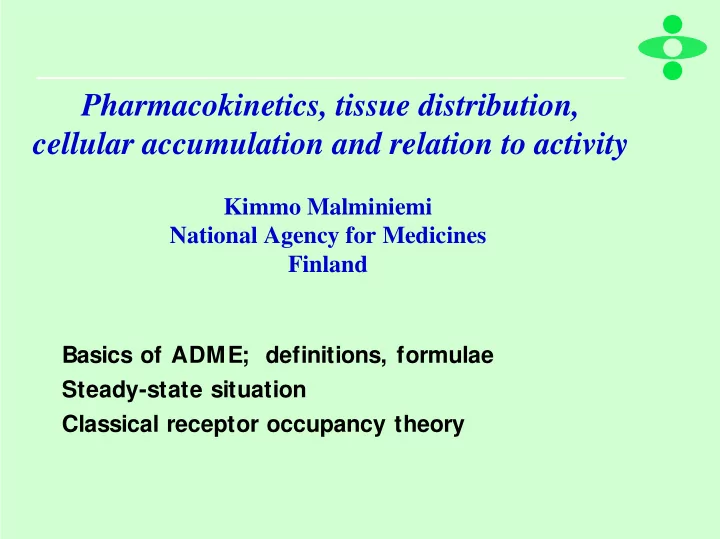

Pharmacokinetics, tissue distribution, cellular accumulation and relation to activity Kimmo Malminiemi National Agency for Medicines Finland Basics of ADME; definitions, formulae Steady-state situation Classical receptor occupancy theory
Pharmacokinetics • Absorption • Distribution • Metabolism • Excretion
Plasma concentration after oral administration C max C max = observed peak concentration C P T max = time to peak T½ elim = apparent half-life of elimination T½ elim time Lag time T max AUC = area under the Absorption plasma concentra- phase tion - time curve Distribution phase Oral dose Elimination phase
Volume of distribution V dist = amount of drug in body / concentration F = bioavailability F * Dose Clear * T½ elim V appr = k elim = elimination = k elim * AUC 0.693 time constant = 0.693 / T½ elim
Steady-state concentration in plasma • modified from Goodman & Gilman’s The Pharmacological Basis of Therapeutics
Concentration in plasma, formulae F * Dose F * Dosing rate F = bioavailability C SS = = Dint = dosage Clear * Dint Clear interval Peak: Trough: F * Dose / V SS C max = C min = frac * C max 1 - frac Where V SS = volume of distribution at steady state frac = fraction of the last dose in the body at the end of a dosing interval frac = 1 - exp (- 0.693 * Dint / T½ elim )
Accumulation in tissues Factors affecting accumulation • pH gradient; generally, only unionized form penetrates lipid membranes • binding to intracellular constituents • partitioning into lipid phase Consequences • reservoir : retarded release • prolonged action, compared to T½ elim from plasma
Classical receptor occupancy theory k 1 eff DrugRec Stimulus Response Drug + Rec k 2 ( ) [Drug] x [Rec] x eff Response = Fnc [Drug] + k 2 /k 1 Signal EC 50 = concentration needed Efficacy: L> M amplification for half-maximal effect Potency: L> N
Receptor - stimulus - response, examples Receptor binding effect organ effect Beta-2 AR G S , adenyl cyclase vasodilation Alpha-1 AR G I , phospholipases vasoconstriction N M cholinerg Na + -channel depolarization 5-HT 2A phospholipase C platelet aggregation Estrogen ER α DNA ERE activation mRNA synthesis AT 1 -R PLA, Janus kinase gene transcription Insulin receptor tyrosine kinase… …cell growth Dihydrofolate inhibition of inhibition of reductase the enzyme DNA synthesis 50 S ribosomal translocation of inhibition of unit tRNA protein synthesis bacteriostatic effect
Order of affinity to receptor: A > B > C Receptor binding
Inefficient coupling of receptor occupancy
Moderate coupling of receptor occupancy
Highly efficient coupling
Recommend
More recommend